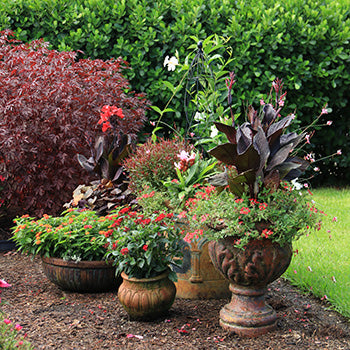The backbone of the summer garden, geraniums provide nonstop color in beds or containers from late spring until fall. Actually members of the Pelargonium family (true geraniums are an unrelated group of perennial plants), these easy-care sun-lovers come in an almost unlimited range of colors, and sizes. Here’s what to look for when you visit your local garden center.

Zonal Geraniums
Chances are you’re already familiar with zonal geraniums. The most common form of geranium, get their name from
the dark zone-like patterns of bronze, purple, or dark green found on the surface of the leaves that darken as the
foliage matures. Zonal geraniums have an upright stance and come in a variety of colors white, red, crimson,
burgundy, peach, salmon, and bi-color. Zonal geraniums are tough, resilient plants that prefer slightly dry
conditions. Hot, humid weather can cause your plants to fail. To keep them in top form you’ll need to clip away the
flower heads as they fade.
Shopping tips:
When shopping for zonal geraniums avoid those with yellow foliage or any that have lost their lower leaves.

Variegated Geraniums
Prized as much for their brightly colored leaves as they are for their colorful flowers, variegated geraniums look
great in containers by themselves or mixed with other annual bloomers. A form of zonal geranium, variegated types
have an upright form and can grow 2 to 3 feet tall. These plants look great even when they are not in bloom. Most
have bi-colored or tri-colored leaves. Some classic variegated selections to watch for include:
- 'Ice Queen' (green with white edges)
- 'Happy Thought' (cream with green edges)
- 'Mrs. Henry Cox' (green and bronze with cream edges)
- 'Mrs. Pollock' (green, bronze, and cream)
- 'Vancouver Centennial' (bronze and gold)
- 'Wilhelm Langguth' (green and white)
Shopping tips:
When shopping for variegated geraniums look for short, stocky plants. Avoid tall, leggy specimens or those with lots of dried up, crinkly leaves at the base of the plant. Most variegated-leaf geraniums don't bloom as profusely as their cousins, so don't be alarmed if you don't see as many blooms on the plants in the store -- or in your garden.

Seed Geraniums
For a new it’s often hard to tell a seed geranium from a zonal geranium. In fact, they actually look quite a bit
alike, but seed geraniums can generally be identified by how they are sold. Zonal geraniums are most often sold in
individual pots, but seed geraniums are generally offered in larger groups or flats and they cost less than . Seed
geraniums are heavy bloomers and are ideal if you want to fill an entire bed or landscape with plants. These
easy-care annuals are generally shorter and more compact than and produce single flowers in a wide range of colors.
Shopping tips:
When shopping for seed geraniums look for stocky plants with bright green foliage. Avoid any that have dried out with shriveled leaves and stems.

Ivy Geraniums
You can’t beat ivy geraniums for hanging baskets, window boxes, or tall, vertical containers where the plants’ handsome foliage can trail over the edge like a waterfall of blooms. Ivy geraniums get their name from their trailing habit and ivy-shaped leaves. Once established, ivy geraniums grow quickly and can spread several feet in any direction. Ivy geraniums are available in different sizes; smaller, denser, varieties are occasionally called balcony geraniums. Colors include red, pink, white, salmon, burgundy, lavender, and bi-color. To keep your plants blooming continuously, remove the flowers as they fade and feed them every few weeks with an all-purpose liquid fertilizer.
Shopping tips:
When shopping for ivy geraniums look for tight, dense plants with plenty of flower buds.

Interspecific Hybrid Geraniums
Don’t let the name of this group of geraniums intimidate you. Interspecific Hybrid geraniums are simply the offspring of upright zonal geraniums crossbred with common ivy varieties. The result is a plant that combines the best traits of both parents: nonstop flower production, a dense mounded or slightly trailing habit, and heat and drought tolerance. Popular interspecific geraniums include varieties such as Calliope and Caliente.
Shopping tips:
When shopping for these beauties look for rich, dark foliage topped with flashy flowers in colors that include red, coral, pink, lavender, and orange.

Scented Geraniums
All you have to do is gently brush or rub a scented geranium leaf to enjoy its rich fragrance. Scented geraniums come in an extensive selection of scents and leaf shapes. Popular scented geraniums include lemon, lime, rose, orange, mint, and cedar. One variety, ‘Cintronella’ is thought to repel mosquitoes, but sadly the claims are not true. Scented geraniums produce small pink or white flowers throughout the summer.
Shopping tips:
When shopping for scented geraniums read the plant label before you buy. Some varieties remain tight and compact while others can grow 3 feet tall and wide so select plants that will fit your space. Also, rub the leaves before purchasing to be sure the scent is pleasing to you.
Martha Washington Geraniums
The jewel-like flowers of Martha Washington geraniums are so showy that the plants are often found in florist shops as well as your local garden center. These glamorous occasionally called regal geraniums, produce a canopy of bi-colored pink, lavender, white, and burgundy, blooms. Unlike other geraniums, Martha Washington varieties do not like hot, sunny weather and do best in cooler, wetter climates. Once the initial set of blooms fade, it can be difficult to bring them back into flower. They make excellent gift plants, but in the their performance can be short lived.
Shopping tips:
When purchasing Martha Washington geraniums look for bright green foliage and choose plants just starting to bloom. Avoid plants with flowers that are already starting to fade.
















